Exploring the Effect of Different Waste Fillers in Manufactured Sustainable Plastic Aggregates Matrix on the Structural Lightweight Green Concrete
Abstract
:1. Introduction
2. Materials, Experimental Plan, and Procedures
2.1. Ingredient Properties
2.2. Concrete Mix Formulation and Test Methods
3. Results and Discussion
3.1. Manufacturing of Green Plastic Aggregate
3.2. Green Synthetic Lightweight Aggregate Investigation
3.2.1. Shape and Texture
3.2.2. Sieve Analysis
3.2.3. Fineness Modulus
3.2.4. Bulk Specific Gravity
3.2.5. Water Absorption
3.2.6. Unit Weight
3.2.7. Aggregate Void Content
3.2.8. Strength
3.3. Green Lightweight Concrete Investigation
3.3.1. Fresh Properties of Green-Manufactured Plastic Aggregates Concrete
3.3.2. Hardened Properties of Green-Manufactured Plastic Aggregates Concrete
Dry Density
Compressive Strength
Flexural Strength
Splitting Tensile Strength
Microscopic Investigations
3.3.3. Durability-Related Properties of Green Manufactured Plastic Aggregates Concrete
4. Conclusions
- The addition of different filler has modified the properties of the developed aggregate. The dune dust addition caused the aggregates to be rougher as compared to quarry fines and fly ash. The manufactured aggregates developed by using dune dust were coarser and had the highest bulk specific gravity among the three filler types.
- The water absorption values were found to be lowest for the aggregates manufactured using fly ash fillers as compared to quarry fines and dune dust. Furthermore, the increase in the percentage of fillers in the aggregate matrix (50 to 70%) caused the water absorption to increase by 55, 116, and 77% for dune dust, fly ash, and quarry dust respectively. Furthermore, the results of the impact test have demonstrated a decrease of 24.7, 43.6, and 29% in the strength values when the percentage of fillers was increased from 50 to 70% for dune dust, fly ash, and quarry dust respectively.
- The addition of different fillers in the aggregate matrix has altered the slump and dry density results of resulting concrete, however, except GMPA2 (manufactured aggregates composed of 50% fly ash and 50% plastic) satisfied the workability (i.e., 75–125 mm) and density (i.e., 1400–1900 kg/m3) requirements of structural lightweight concrete specified in [63].
- The compressive, flexural, and splitting tensile strength of concrete containing green manufactured plastic aggregates have shown a decrease with reference to normal as well as natural lightweight concrete, irrespective of the filler type. Furthermore, the chloride permeability test results have shown the increased durability of concretes made with green manufactured plastic aggregates as compared to normal as well as natural lightweight concrete. The durability increased with an increase in the filler percentage for all filler types.
- Although, the majority of the concrete made in the current study by using green manufactured plastic aggregates have satisfied the criteria mentioned in [56] demonstrating its ability for lightweight structural uses, GMPA3 (manufactured aggregates composed of 50% quarry dust and 50% plastic) appeared to be the best choice. Overall, the green manufactured plastic aggregates have demonstrated their capacity for structural lightweight construction projects with effective utilization of plastic waste and industrial by-products.
Author Contributions
Funding
Institutional Review Board Statement
Informed Consent Statement
Data Availability Statement
Acknowledgments
Conflicts of Interest
References
- Zafar, I. Sustainable Alternatives for Green Mortar: Quarry Waste and Ultra high fly ash utilization. IOP Conf. Series: Earth Environ. Sci. 2022, 1026, 012034. [Google Scholar] [CrossRef]
- Mouli, M.; Khelafi, H. Performance characteristics of lightweight aggregate concrete containing natural pozzolan. Build. Environ. 2008, 43, 31–36. [Google Scholar] [CrossRef]
- Shi, J.; Liu, B.; Liu, Y.; Wang, E.; He, Z.; Xu, H.; Ren, X. Preparation and characterization of lightweight aggregate foamed geopolymer concretes aerated using hydrogen peroxide. Constr. Build. Mater. 2020, 256, 119442. [Google Scholar] [CrossRef]
- Shi, J.; Tan, J.; Liu, B.; Liu, Y.; Xu, H.; Wang, Z.; Xiong, T.; Shi, J. Thermal and mechanical properties of thermal energy storage light-weight aggregate mortar incorporated with phase change material. J. Energy Storage 2020, 32, 101719. [Google Scholar] [CrossRef]
- Siddique, R.; Khatib, J.; Kaur, I. Use of recycled plastic in concrete: A review. Waste Manag. 2008, 28, 1835–1852. [Google Scholar] [CrossRef]
- Abu-Saleem, M.; Zhuge, Y.; Hassanli, R.; Ellis, M.; Rahman, M.; Levett, P. Evaluation of concrete performance with different types of recycled plastic waste for kerb application. Constr. Build. Mater. 2021, 293, 123477. [Google Scholar] [CrossRef]
- Albano, C.; Camacho, N.; Hernández, M.; Matheus, A.; Gutiérrez, A. Influence of content and particle size of waste pet bottles on concrete behavior at different w/c ratios. Waste Manag. 2009, 29, 2707–2716. [Google Scholar] [CrossRef]
- Remadnia, A.; Dheilly, R.; Laidoudi, B.; Quéneudec, M. Use of animal proteins as foaming agent in cementitious concrete composites manufactured with recycled PET aggregates. Constr. Build. Mater. 2009, 23, 3118–3123. [Google Scholar] [CrossRef]
- Rahmani, E.; Dehestani, M.; Beygi, M.H.A.; Allahyari, H.; Nikbin, I.M. On the mechanical properties of concrete containing waste PET particles. Constr. Build. Mater. 2013, 47, 1302–1308. [Google Scholar] [CrossRef]
- Juki, M.I.; Awang, M.; Annas, M.M.K.; Boon, K.H.; Othman, N.; Kadir, A.B.A.; Roslan, M.A.; Khalid, F.S. Relationship between Compressive, Splitting Tensile and Flexural Strength of Concrete Containing Granulated Waste Polyethylene Terephthalate (PET) Bottles as Fine Aggregate. Adv. Mater. Res. 2013, 795, 356–359. [Google Scholar] [CrossRef]
- Frigione, M. Recycling of PET bottles as fine aggregate in concrete. Waste Manag. 2010, 30, 1101–1106. [Google Scholar] [CrossRef] [PubMed]
- Ferreira, L.; de Brito, J.; Saikia, N. Influence of curing conditions on the mechanical performance of concrete containing recycled plastic aggregate. Constr. Build. Mater. 2012, 36, 196–204. [Google Scholar] [CrossRef]
- Silva, R.V.; de Brito, J.; Saikia, N. Influence of curing conditions on the durability-related performance of concrete made with selected plastic waste aggregates. Cem. Concr. Compos. 2013, 35, 23–31. [Google Scholar] [CrossRef]
- Saikia, N.; de Brito, J. Waste polyethylene terephthalate as an aggregate in concrete. Mater. Res. 2013, 16, 341–350. [Google Scholar] [CrossRef] [Green Version]
- Saikia, N.; de Brito, J. Mechanical properties and abrasion behaviour of concrete containing shredded PET bottle waste as a partial substitution of natural aggregate. Constr. Build. Mater. 2014, 52, 236–244. [Google Scholar] [CrossRef]
- Hannawi, K.; Kamali-Bernard, S.; Prince, W. Physical and mechanical properties of mortars containing PET and PC waste aggregates. Waste Manag. 2010, 30, 2312–2320. [Google Scholar] [CrossRef] [PubMed]
- Batayneh, M.; Marie, I.; Asi, I. Use of selected waste materials in concrete mixes. Waste Manag. 2007, 27, 1870–1876. [Google Scholar] [CrossRef]
- Ismail, Z.Z.; Al-Hashmi, E.A. Use of waste plastic in concrete mixture as aggregate replacement. Waste Manag. 2008, 28, 2041–2047. [Google Scholar] [CrossRef]
- Rai, B.; Rushad, S.T.; Kr, B.; Duggal, S.K. Study of Waste Plastic Mix Concrete with Plasticizer. ISRN Civ. Eng. 2012, 2012, 29–32. [Google Scholar] [CrossRef] [Green Version]
- Choi, Y.-W.; Moon, D.-J.; Chung, J.-S.; Cho, S.-K. Effects of waste PET bottles aggregate on the properties of concrete. Cem. Concr. Res. 2005, 35, 776–781. [Google Scholar] [CrossRef]
- Choi, Y.W.; Moon, D.J.; Kim, Y.J.; Lachemi, M. Characteristics of mortar and concrete containing fine aggregate manufactured from recycled waste polyethylene terephthalate bottles. Constr. Build. Mater. 2009, 23, 2829–2835. [Google Scholar] [CrossRef]
- Tang, W.; Lo, Y.; Nadeem, A. Mechanical and drying shrinkage properties of structural-graded polystyrene aggregate concrete. Cem. Concr. Compos. 2008, 30, 403–409. [Google Scholar] [CrossRef]
- Chen, B.; Liu, J. Properties of lightweight expanded polystyrene concrete reinforced with steel fiber. Cem. Concr. Res. 2004, 34, 1259–1263. [Google Scholar] [CrossRef]
- Ben Fraj, A.; Kismi, M.; Mounanga, P. Valorization of coarse rigid polyurethane foam waste in lightweight aggregate concrete. Constr. Build. Mater. 2010, 24, 1069–1077. [Google Scholar] [CrossRef] [Green Version]
- Sabaa, B.; Ravindrarajah, R.S. Engineering properties of lightweight concrete containing crushed expanded poly-styrene waste. In Proceedings of the Symposium MM: Advances in Materials for Cementitious Composites, Boston, MA, USA, 1–5 December 1997; pp. 1–3. [Google Scholar]
- Ravindrarajah, R.S. Bearing strength of concrete containing polystyrene aggregate. In Proceedings of the RILEM 8th International Confrence: Durability of Building Materials and Components, Vancouver, BC, Canada, 30 May–3 June 1999; Volume 1, pp. 505–514. [Google Scholar]
- Lima, P.; Leite, M.; Santiago, E.Q.R. Recycled lightweight concrete made from footwear industry waste and CDW. Waste Manag. 2010, 30, 1107–1113. [Google Scholar] [CrossRef] [PubMed]
- Rahman, M.M.; Islam, M.A.; Ahmed, M. Recycling of waste polymeric materials as a partial replacement for aggregate in concrete. In Proceedings of the International Conference on Chemical, Environmental and Biological Sciences, Hong Kong, China, 29–30 December 2012. [Google Scholar]
- Al-Manaseer, A.; Dalal, T. Concrete containing plastic aggregates. Concr. Int. 1997, 19, 47–52. [Google Scholar]
- Haghi, A.K.; Arabani, M.; Ahmadi, H. Applications of expanded polystyrene (EPS) beads and polyamide-66 in civil engineering, Part One: Lightweight polymeric concrete. Compos. Interfaces 2006, 13, 441–450. [Google Scholar] [CrossRef]
- Kashi, M.; Swan, C.; Holmstrom, O.; Malloy, R. Innovative lightweight synthetic aggregates developed from coal Flyash. In Proceedings of the 13th International Symposium on Management and Use of Coal Combustion Products, Orlando, FL, USA, 11–15 January 1999; Volume 1, pp. 1–5. [Google Scholar]
- Jansen, D.; Kiggins, M.; Swan, C.; Malloy, R.; Kashi, M.; Chan, R.; Javdekar, C.; Siegal, C.; Weingram, J. Lightweight fly ash-plastic aggregates in concrete. Transportation Research Record: J. Transp. Res. Board 2001, 1175, 44–52. [Google Scholar] [CrossRef]
- Slabaugh, S.; Swan, C.; Malloy, R. Development and properties of Foamed synthetic Lightweight Aggregates. In Proceedings of the World of Coal Ash (WOCA) Conference, Covington, KY, USA, 7–10 May 2007. [Google Scholar]
- Malloy, R.; Desai, N.; Wilson, C.; Swan, C.; Jansen, D.; Kashi, M. High Carbon Fly Ash/Mixed Thermoplastic Aggregate for Use in Lightweight Concrete (859). Tech. Pap. Annu. Tech. Conf.-Soc. Plast. Eng. Inc. 2001, 3, 2743–2752. [Google Scholar]
- Kou, S.C.; Lee, G.; Poon, C.S.; Lai, W.-L. Properties of lightweight aggregate concrete prepared with PVC granules derived from scraped PVC pipes. Waste Manag. 2009, 29, 621–628. [Google Scholar] [CrossRef]
- Sakr, K.; El-Hakim, E. Effect of high temperature or fire on heavy weight concrete properties. Cem. Concr. Res. 2005, 35, 590–596. [Google Scholar] [CrossRef]
- Alqahtani, F.K.; Khan, M.I.; Ghataora, G.; Dirar, S. Production of Recycled Plastic Aggregates and Its Utilization in Concrete. J. Mater. Civ. Eng. 2016, 29, 04016248. [Google Scholar] [CrossRef]
- Alqahtani, F.K.; Ghataora, G.; Khan, M.I.; Dirar, S. Novel lightweight concrete containing manufactured plastic aggregate. Constr. Build. Mater. 2017, 148, 386–397. [Google Scholar] [CrossRef]
- Alqahtani, F.K.; Ghataora, G.; Dirar, S.; Khan, M.I.; Zafar, I. Experimental study to investigate the engineering and durability performance of concrete using synthetic aggregates. Constr. Build. Mater. 2018, 173, 350–358. [Google Scholar] [CrossRef] [Green Version]
- Alqahtani, F.K.; Zafar, I. Characterization of processed lightweight aggregate and its effect on physical properties of concrete. Constr. Build. Mater. 2020, 230, 116992. [Google Scholar] [CrossRef]
- Islam, M.J.; Shahjalal, M. Effect of polypropylene plastic on concrete properties as a partial replacement of stone and brick aggregate. Case Stud. Constr. Mater. 2021, 15, e00627. [Google Scholar] [CrossRef]
- Tayeh, B.A.; Almeshal, I.; Magbool, H.M.; Alabduljabbar, H.; Alyousef, R. Performance of sustainable concrete containing different types of recycled plastic. J. Clean. Prod. 2021, 328, 129517. [Google Scholar] [CrossRef]
- Bamigboye, G.O.; Tarverdi, K.; Umoren, A.; Bassey, D.E.; Okorie, U.; Adediran, J. Evaluation of eco-friendly concrete having waste PET as fine aggregates. Clean. Mater. 2021, 2, 100026. [Google Scholar] [CrossRef]
- ASTM C33/C33M-16; Standard Specification for Concrete Aggregates. ASTM International: West Conshohocken, PA, USA, 2016.
- ASTM C136/C136M-14; Standard Test Method for Sieve Analysis of Fine and Coarse Aggregates. ASTM International: West Conshohocken, PA, USA, 2014.
- ACI 211.2-98; Standard Practice for Selecting Proportions for Structural Lightweight Concrete (Reapproved 2004). American Concrete-ACI Committee 211: Farmington Hills, MI, USA, 1998.
- ASTM C192/C192M-16; Standard Practice for Making and Curing Concrete Test Specimens in the Laboratory. ASTM International: West Conshohocken, PA, USA, 2016.
- ASTM C143/C143M-15; Standard Test Method for Slump of Hydraulic-Cement Concrete. ASTM International: West Conshohocken, PA, USA, 2015.
- ASTM C138/C138M-16; Standard Test Method for Density (Unit Weight), Yield, and Air Content (Gravimetric) of Concrete. ASTM International: West Conshohocken, PA, USA, 2016.
- BS EN 12390-7:2009; Testing Hardened Concrete: Density of Hardened Concrete. British Standards Institution: London, UK, 2009.
- ASTM C579-02; Standard Test Methods for Compressive Strength of Chemical-Resistant Mortars, Grouts, Monolithic Surfacings, and Polymer Concretes. ASTM International: West Conshohocken, PA, USA, 2012.
- ASTM C496/C496M-11; Standard Test Method for Splitting Tensile Strength of Cylindrical Concrete Specimens. ASTM International: West Conshohocken, PA, USA, 2011.
- ASTM C580-02; Standard Test Method for Flexural Strength and Modulus of Elasticity of Chemical-Resistant Mortars, Grouts, Monolithic Surfacings, and Polymer Concretes. ASTM International: West Conshohocken, PA, USA, 2012.
- ASTM C1202-12; Standard Test Method for Electrical Indication of Concrete’s Ability to Resist Chloride Ion Penetration. ASTM International: West Conshohocken, PA, USA, 2012.
- Alqahtani, F.K. Recycled Plastic Aggregate for Use in Concrete. U.S. Patent No. 10,294,155, 21 May 2019. [Google Scholar]
- ASTM C330/C330M-14; Standard Specification for Lightweight Aggregates for Structural Concrete. ASTM International: West Conshohocken, PA, USA, 2014.
- Domone, P.; Illston, J. Construction Materials: Their Nature and Behaviour; CRC Press: Boca Raton, FL, USA, 2010. [Google Scholar]
- Prowell, B.D.; Baker, N.V. Evaluation of New Test Procedures for Determining Bulk Specific Gravity of Fine Aggregate by Automated Methods. Transp. Res. Rec. J. Transp. Res. Board 2004, 1874, 11–18. [Google Scholar] [CrossRef]
- Phillips, P.; Richards, G. The use of mixed polymer waste products to produce paving grade asphalt. In Proceedings of the 3rd Eurasphalt and Eurobitume Congress, Vienna, Austria, 12–14 May 2004. [Google Scholar]
- Swan, C.; Sacks, A. Properties of Synthetic Lightweight Aggregates for use in Pavement Systems. In Advances in Pavement Engineering; ASCE: Reston, VA, USA, 2005; pp. 1–12. [Google Scholar] [CrossRef]
- Koide, H.; Tomon, M.; Sasaki, T. Investigation of the use of waste plastic as an aggregate for lightweight concrete. Sustainable Concrete Construction. In Proceedings of the International Conference at the University of Dundee, Scotland, UK, 9–11 September 2002; Volume 5, pp. 177–185. [Google Scholar]
- BS 812-112:1990; Methods for Determination of Aggregate Impact Value (AIV). British Standards Institution: London, UK, 1990.
- ACI 213R-03; Guide for Structural Lightweight-Aggregate Concrete-ACI Committee 213. American Concrete-ACI Committee 211: Farmington Hills, MI, USA, 2003.
- Hamad, A.J. Size and shape effect of specimen on the compressive strength of HPLWFC reinforced with glass fibres. J. King Saud Univ.-Eng. Sci. 2015, 29, 373–380. [Google Scholar] [CrossRef] [Green Version]
- Neville, A.M. Properties of Concrete; Pearson Education Limited: Essex, UK, 1995. [Google Scholar]
- Raphael, J.M. Tensile strength of concrete. ACI J. Proc. 1984, 81, 158–165. [Google Scholar]
- Marzouk, O.Y.; Dheilly, R.; Queneudec, M. Valorization of post-consumer waste plastic in cementitious concrete composites. Waste Manag. 2007, 27, 310–318. [Google Scholar] [CrossRef] [PubMed]
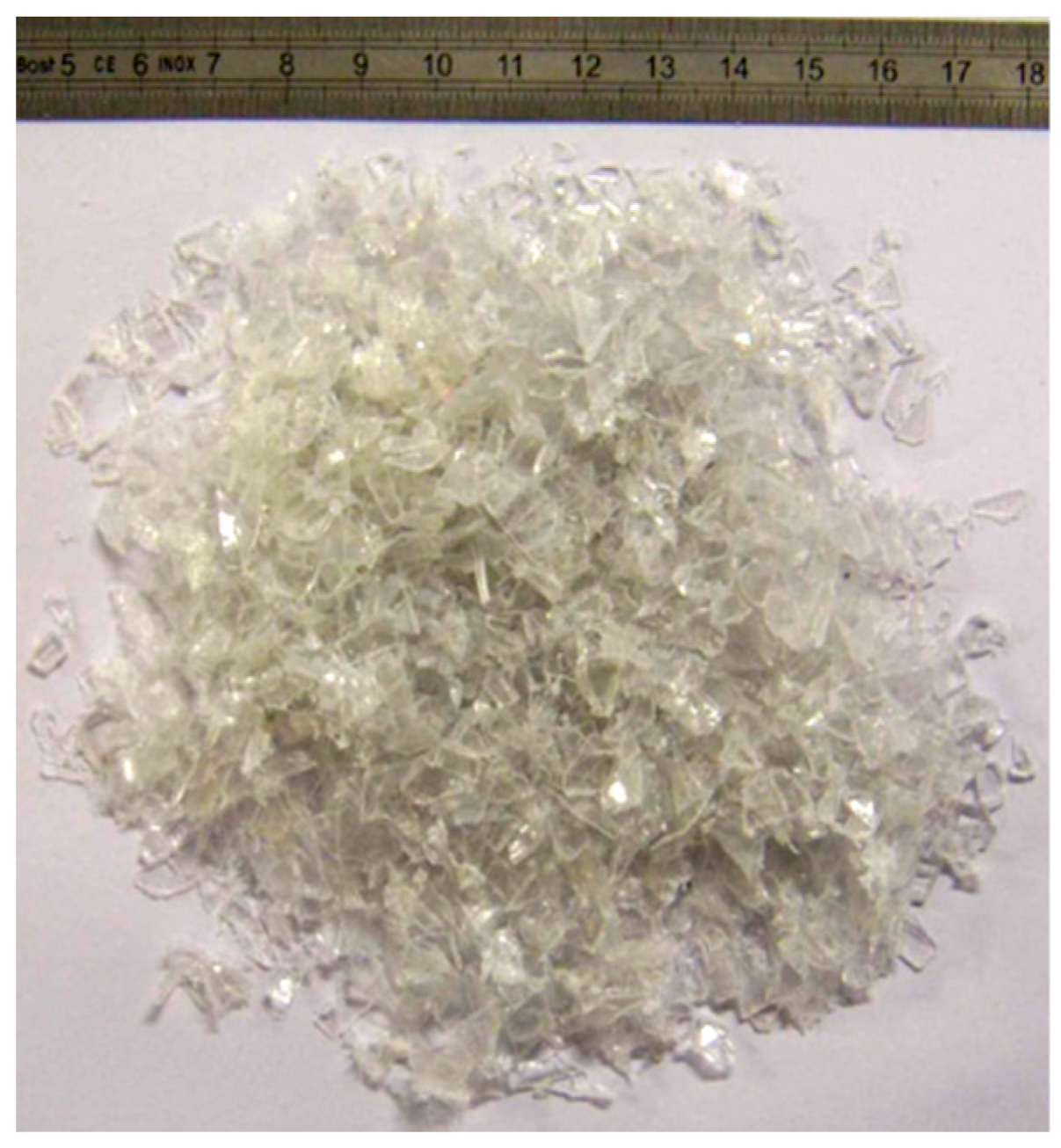
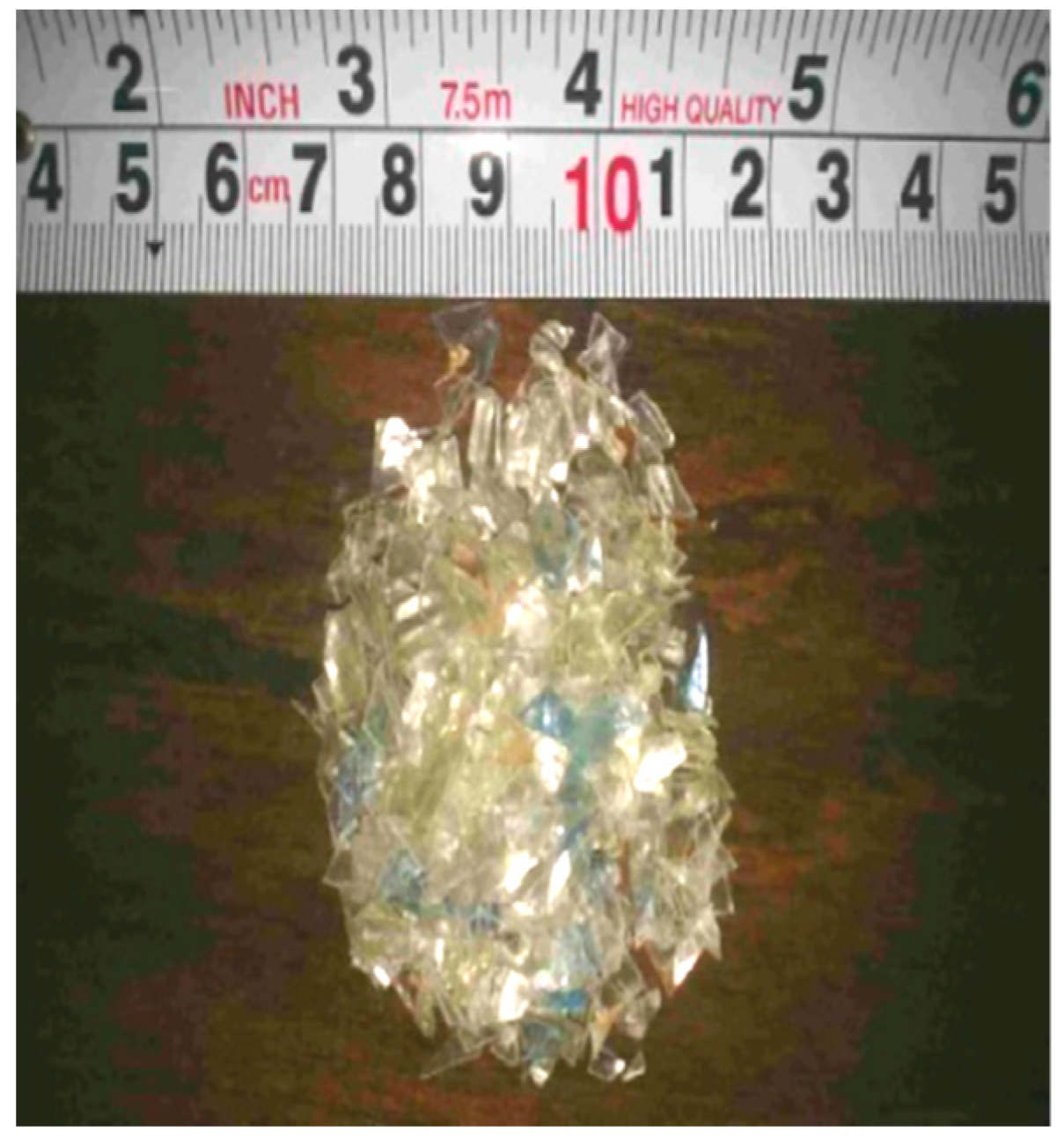

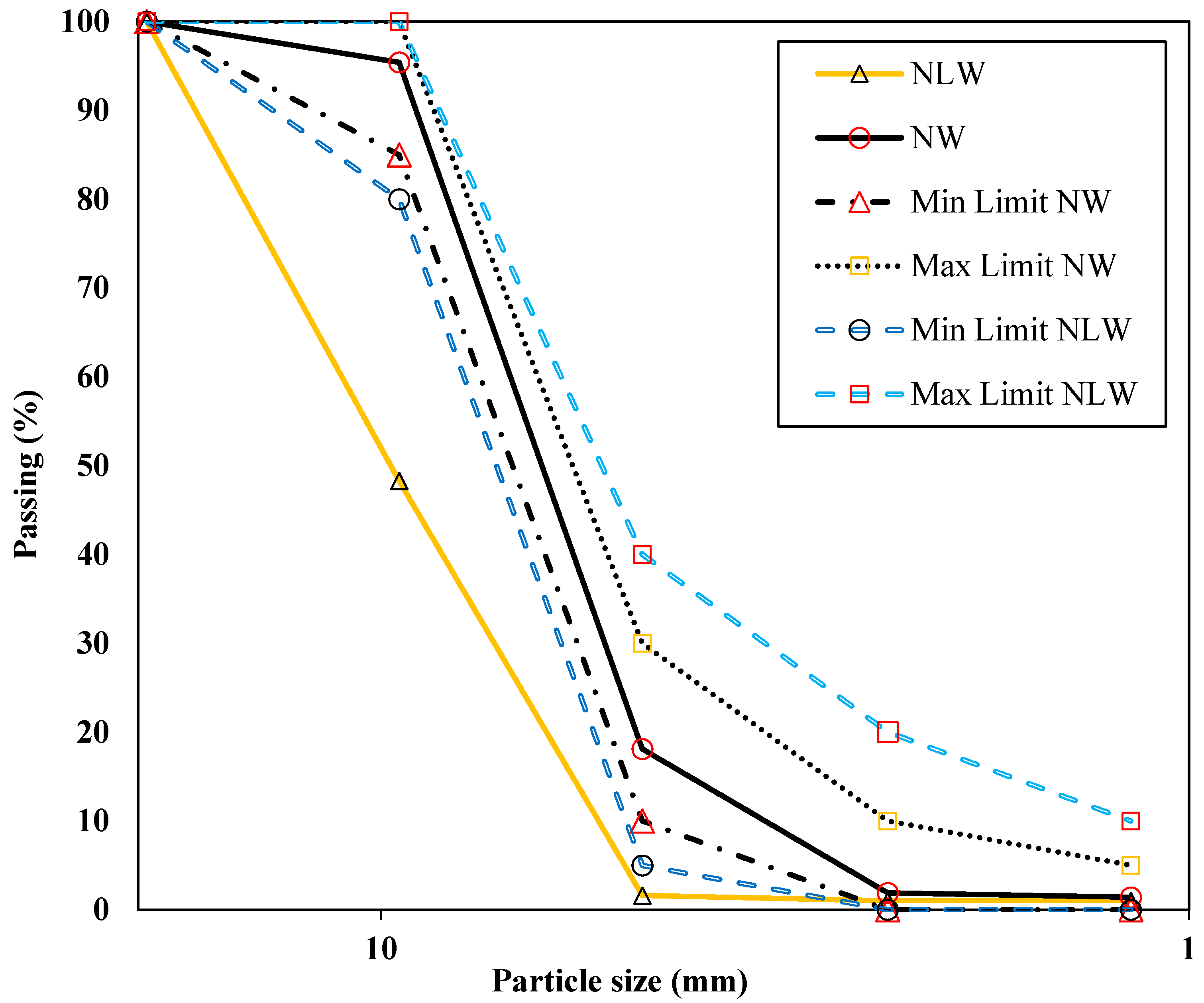
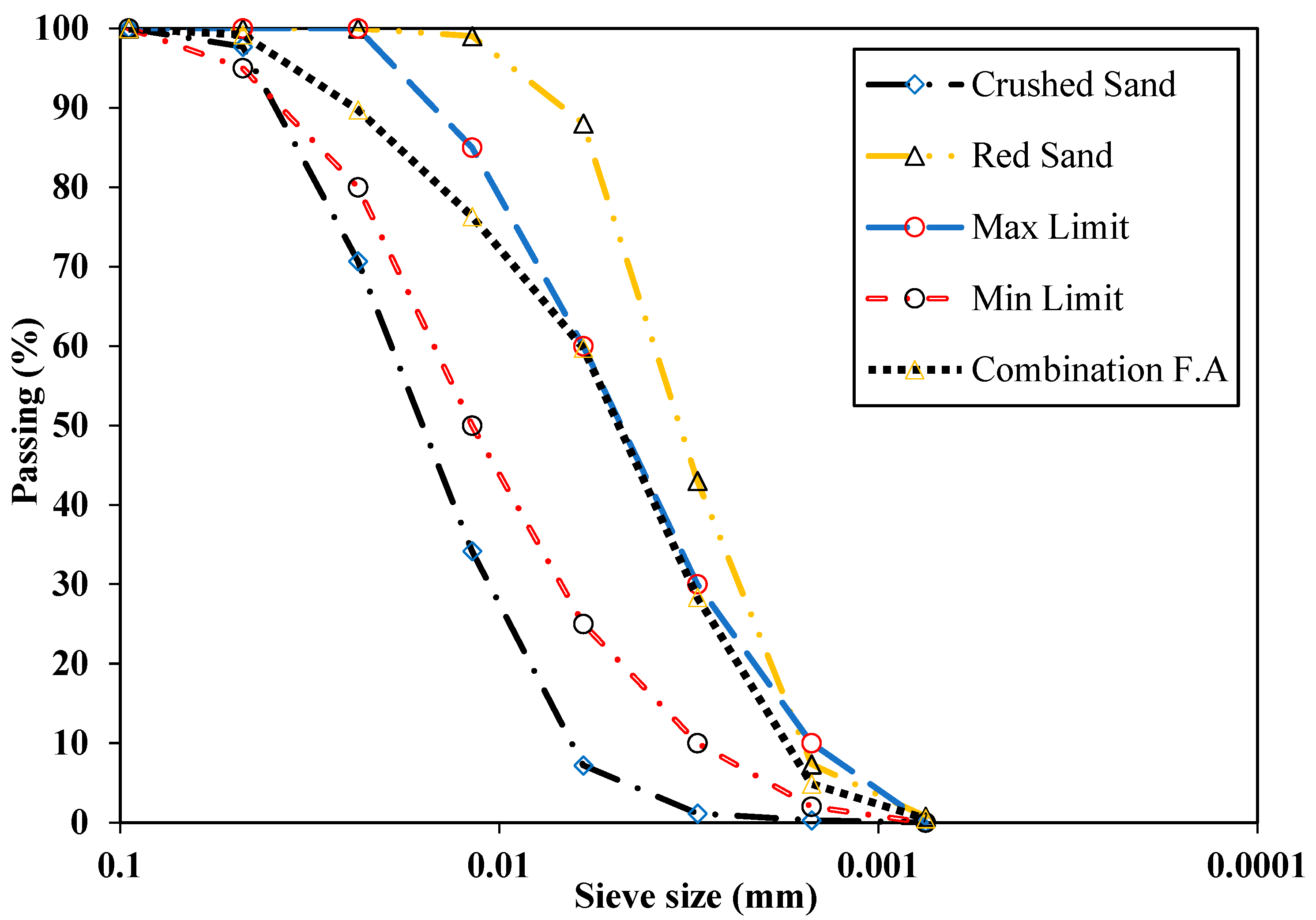
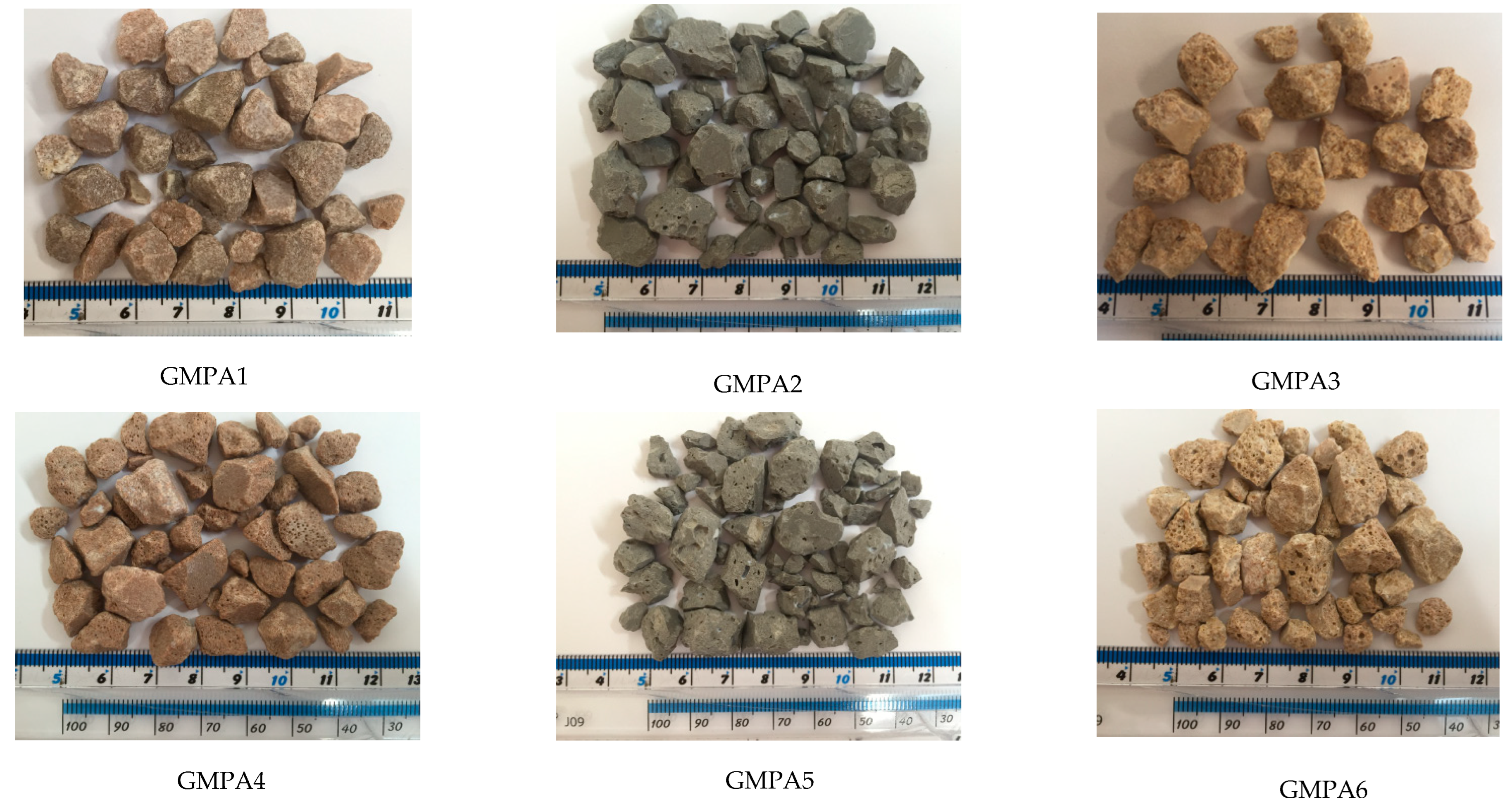

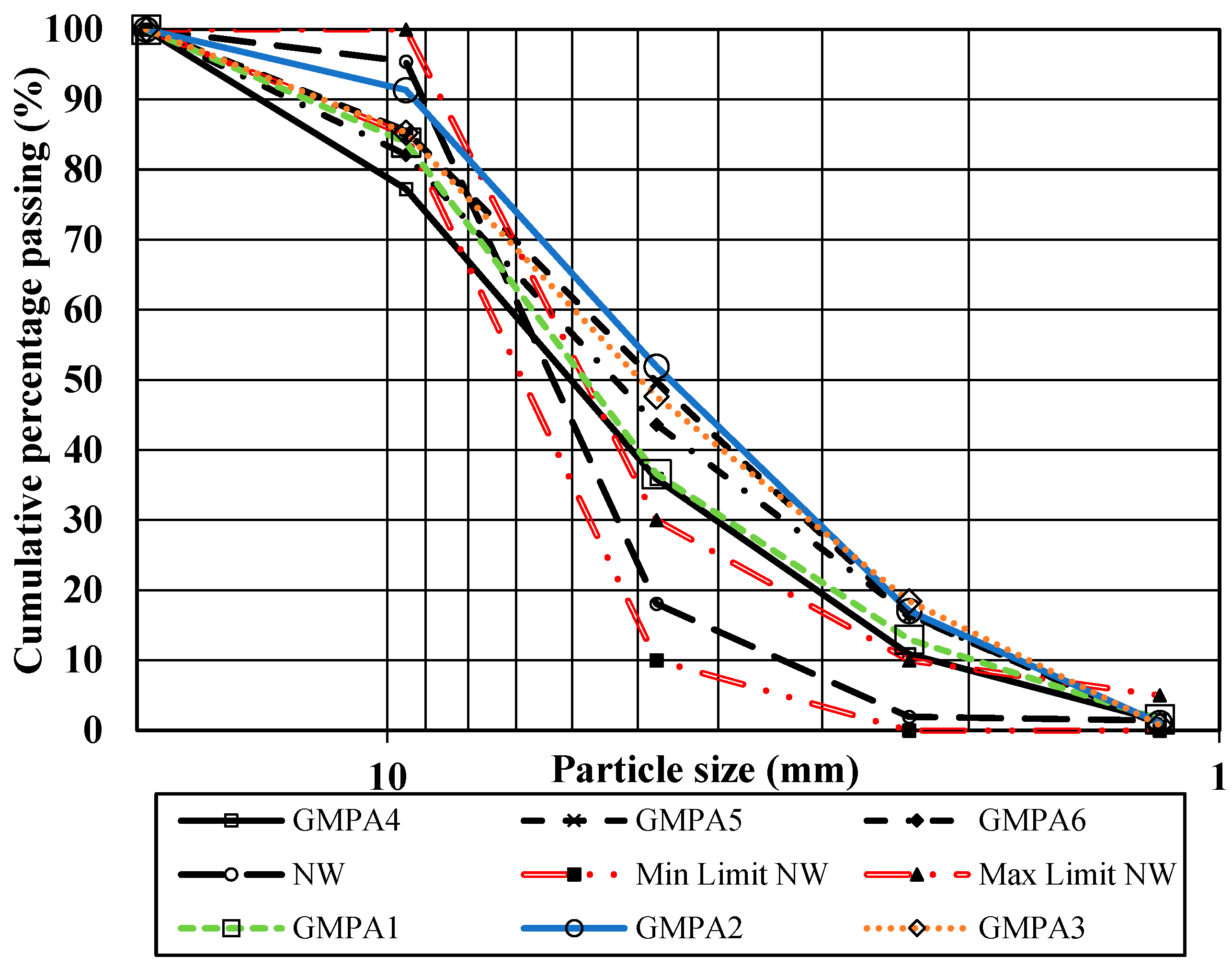

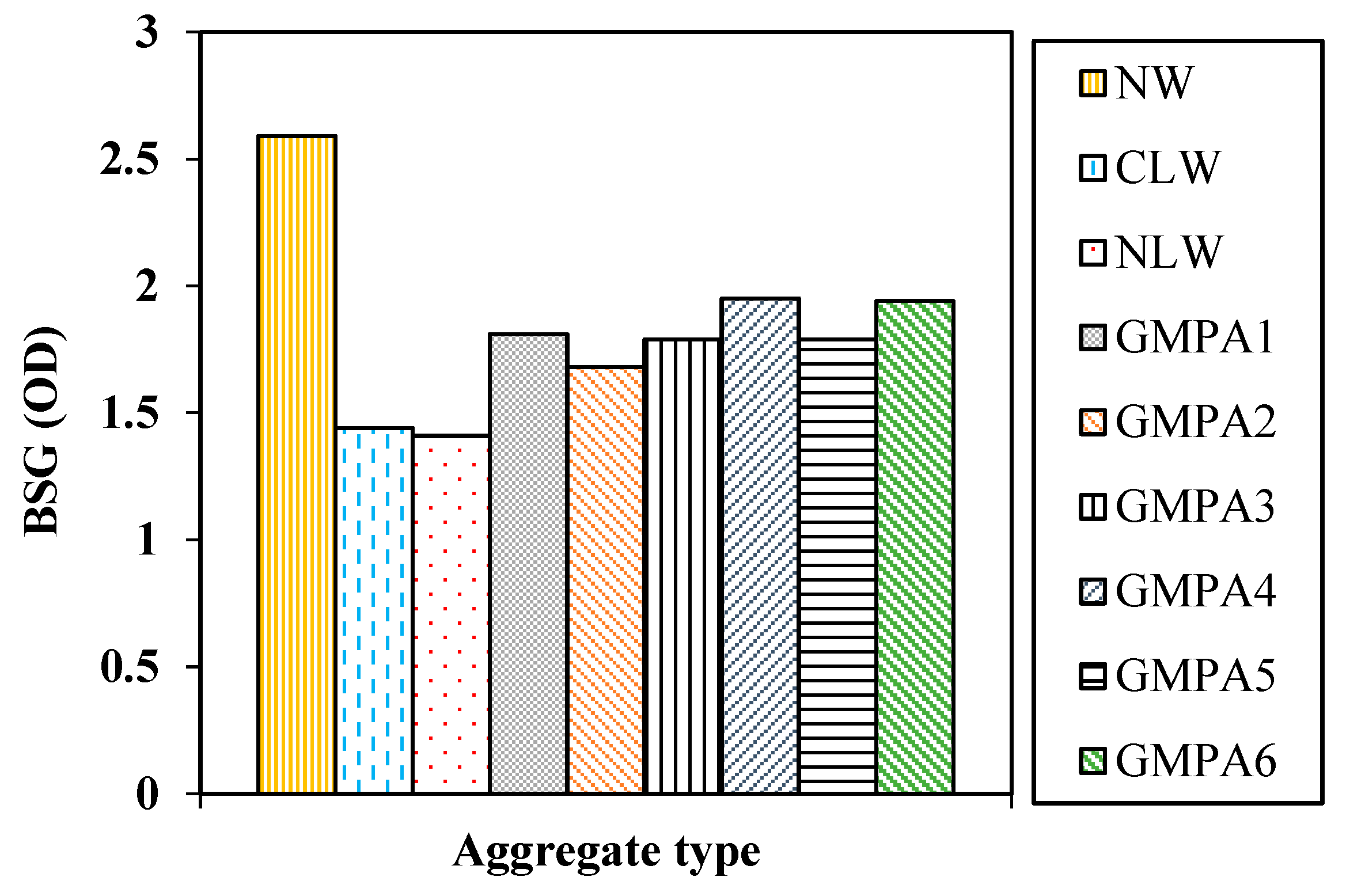

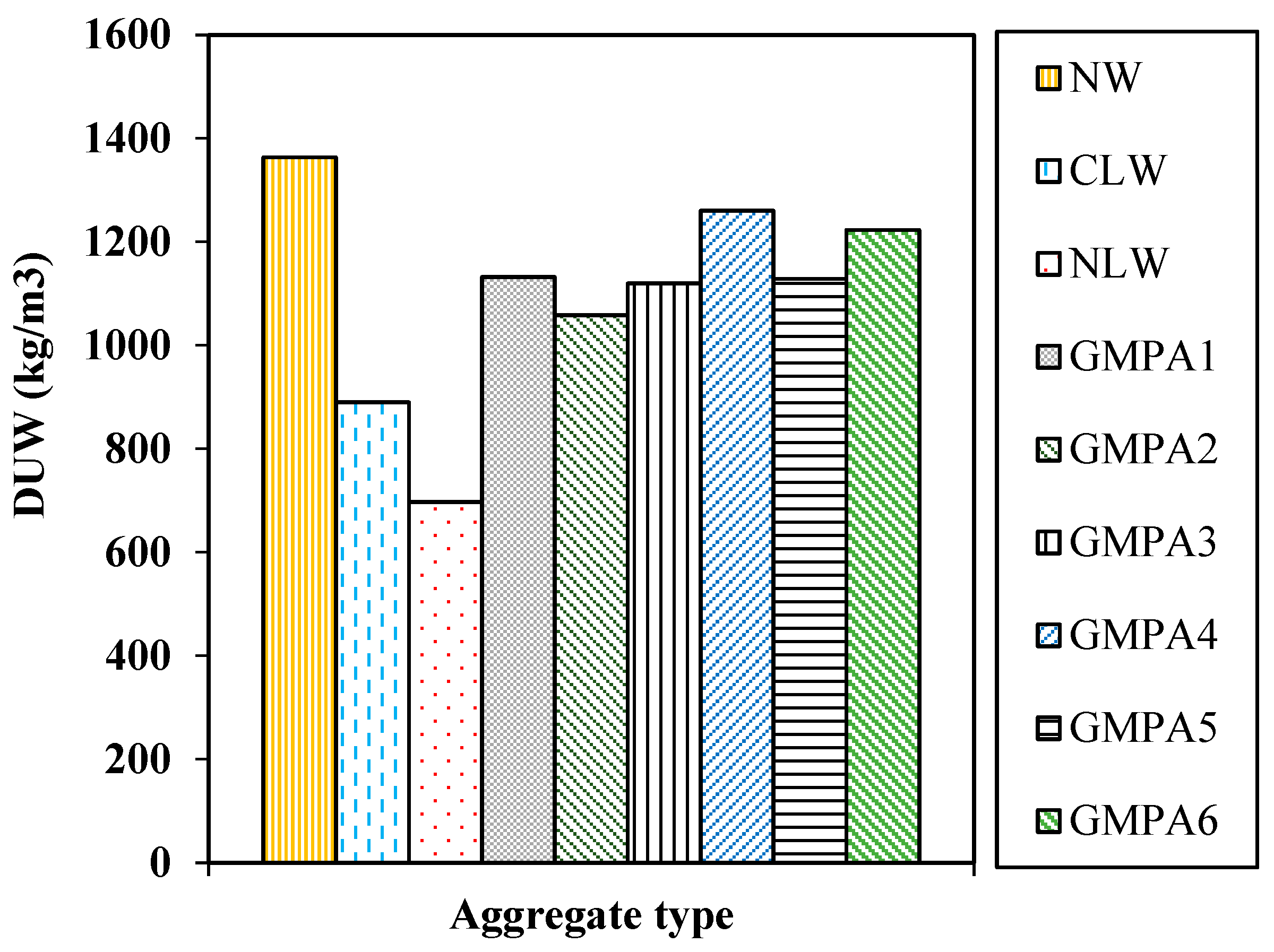

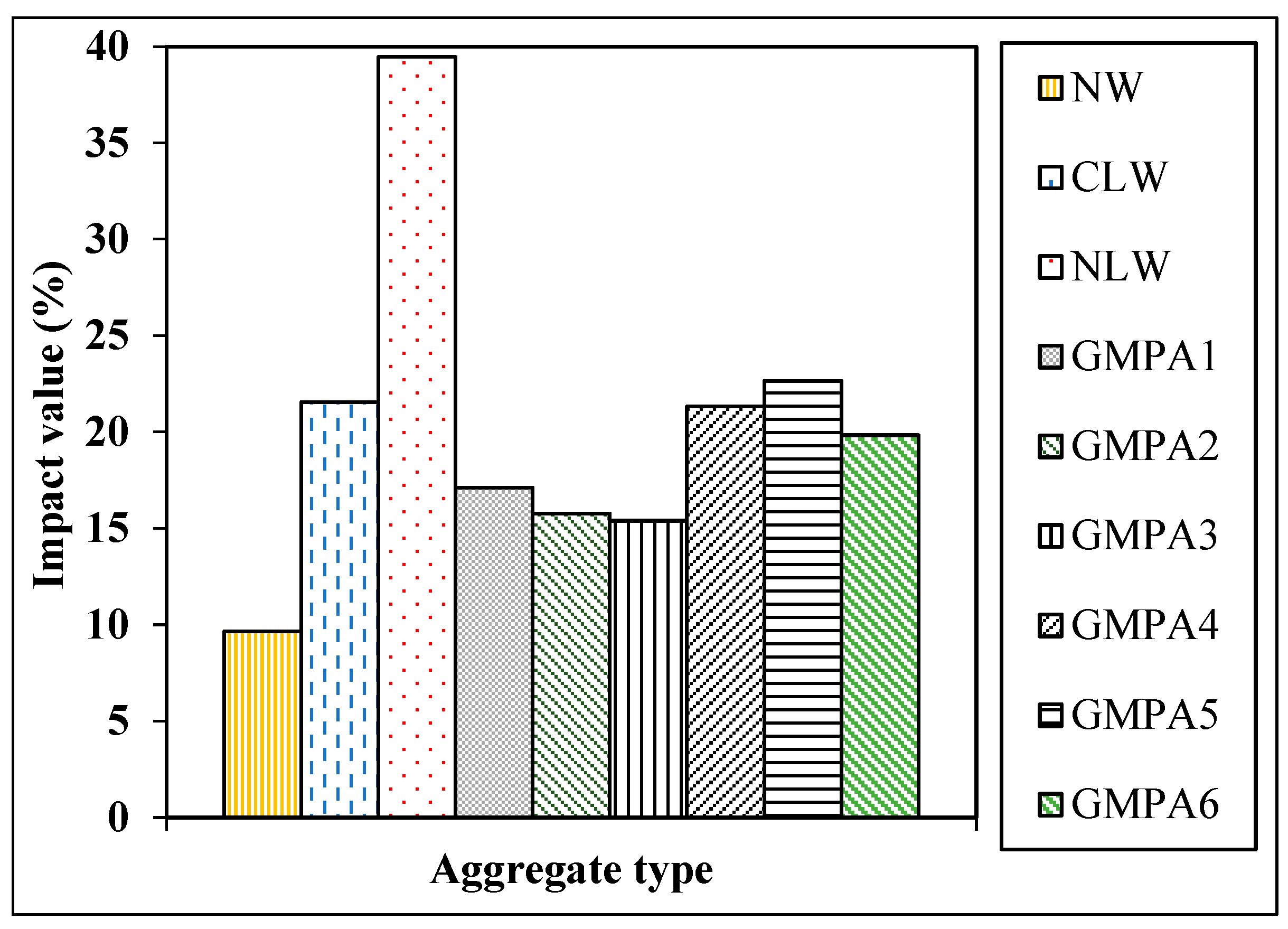


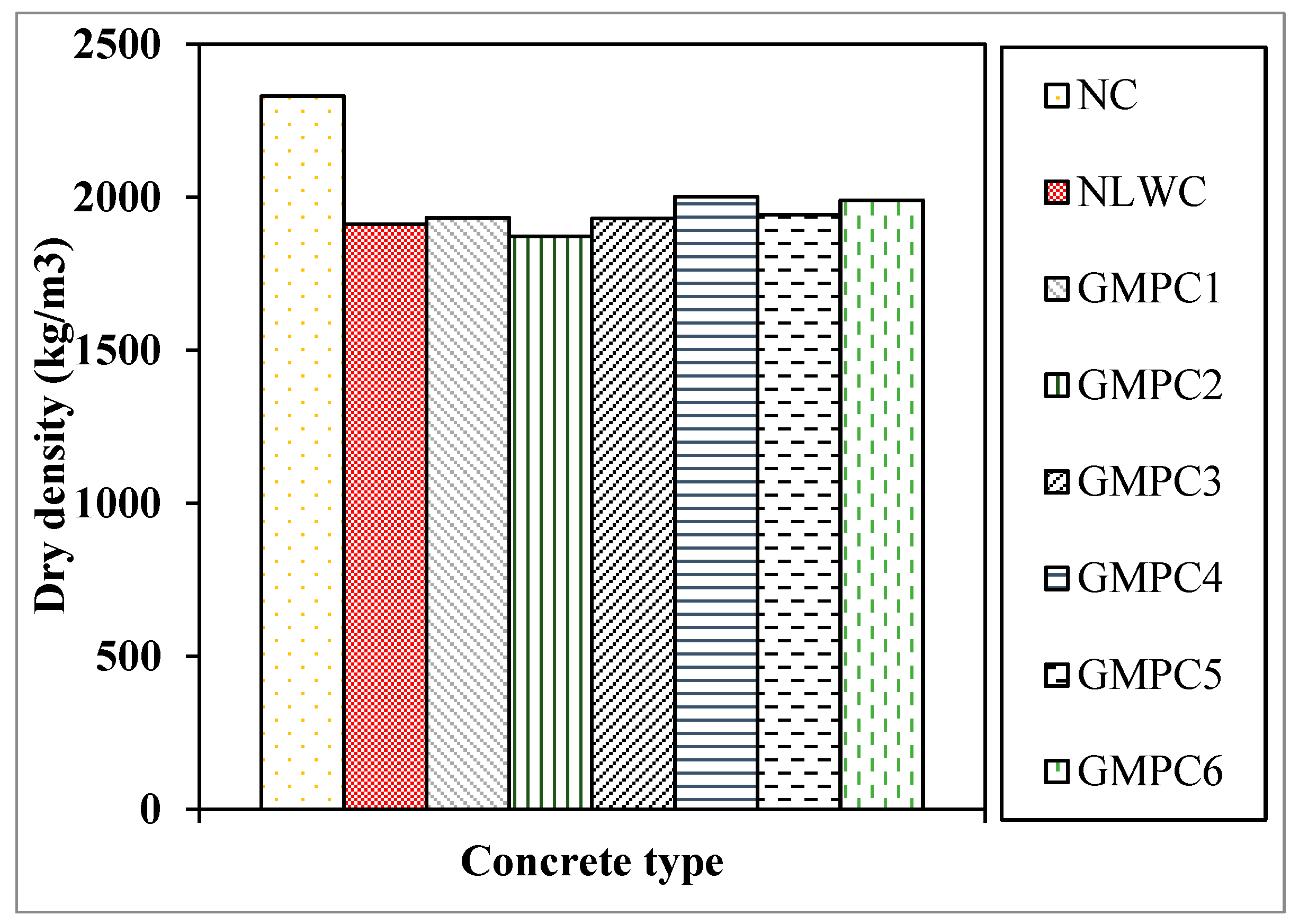
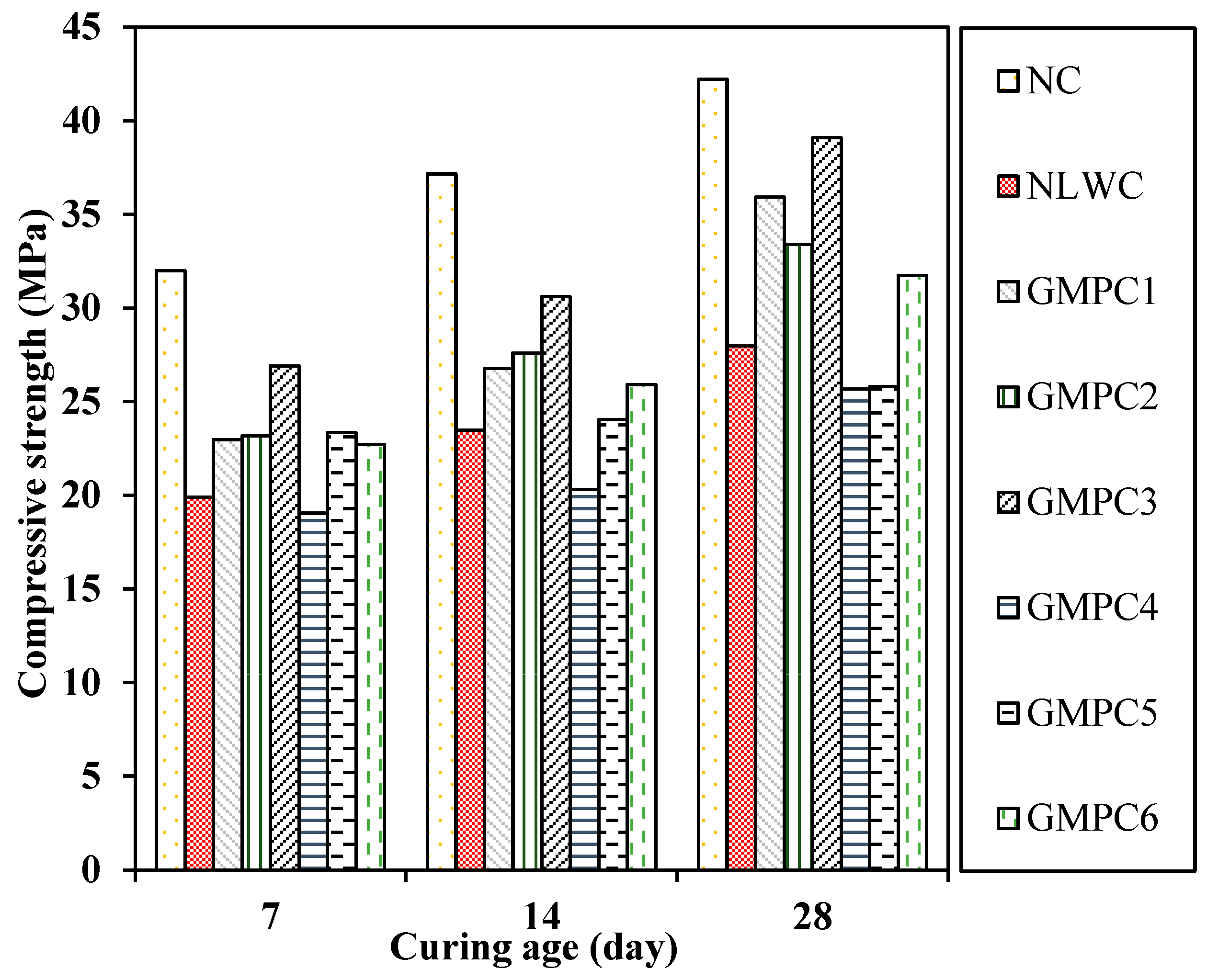

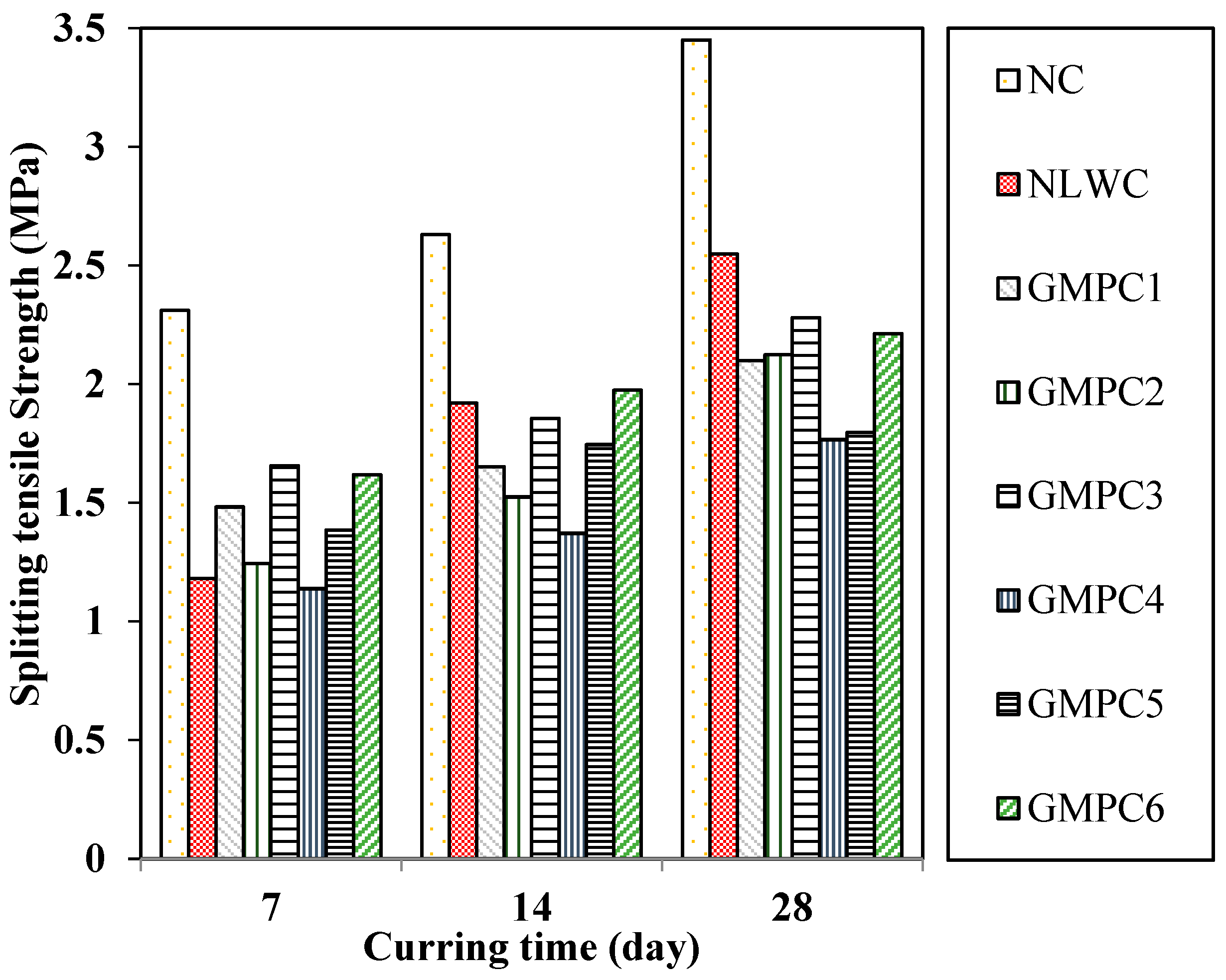
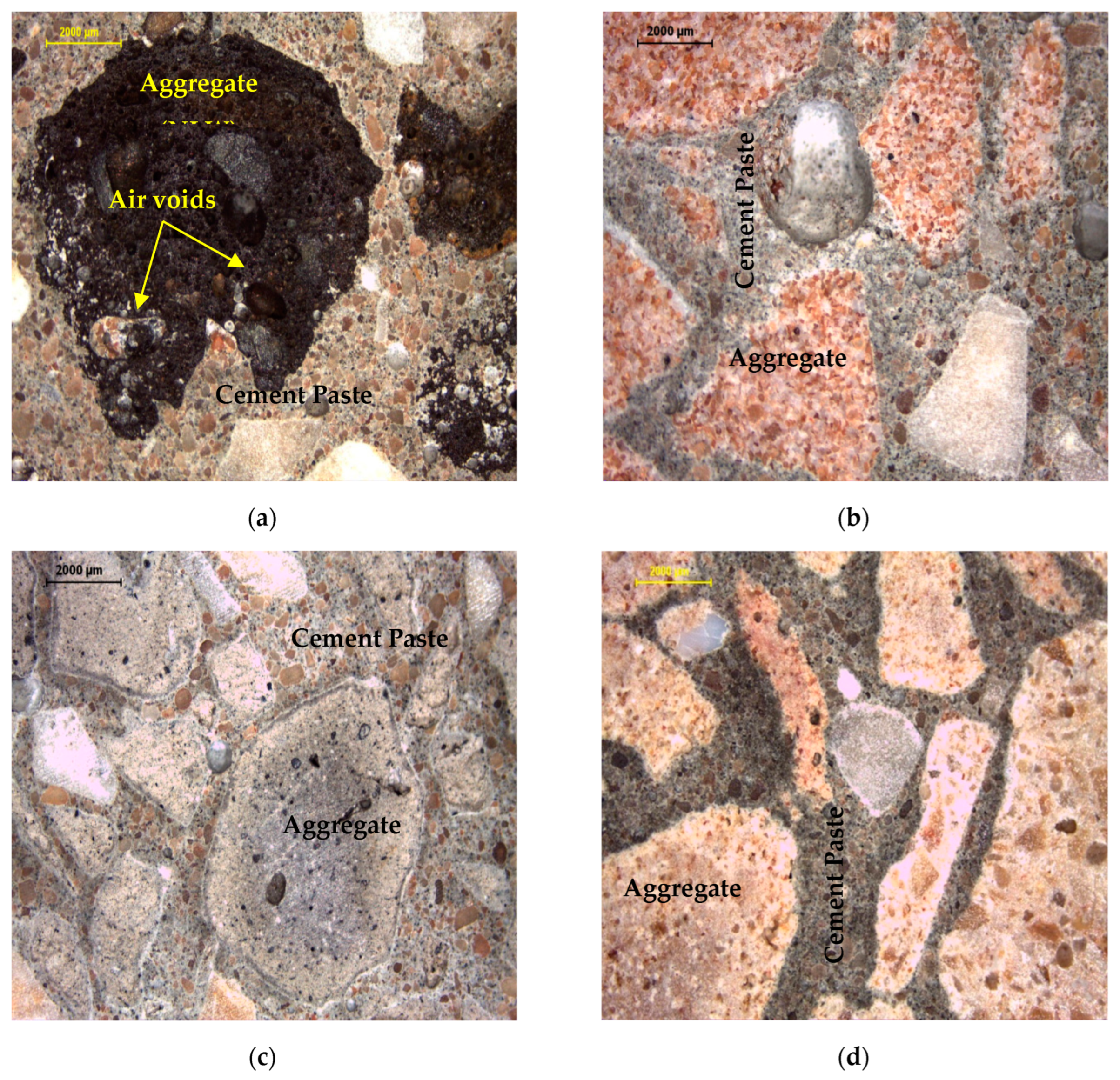
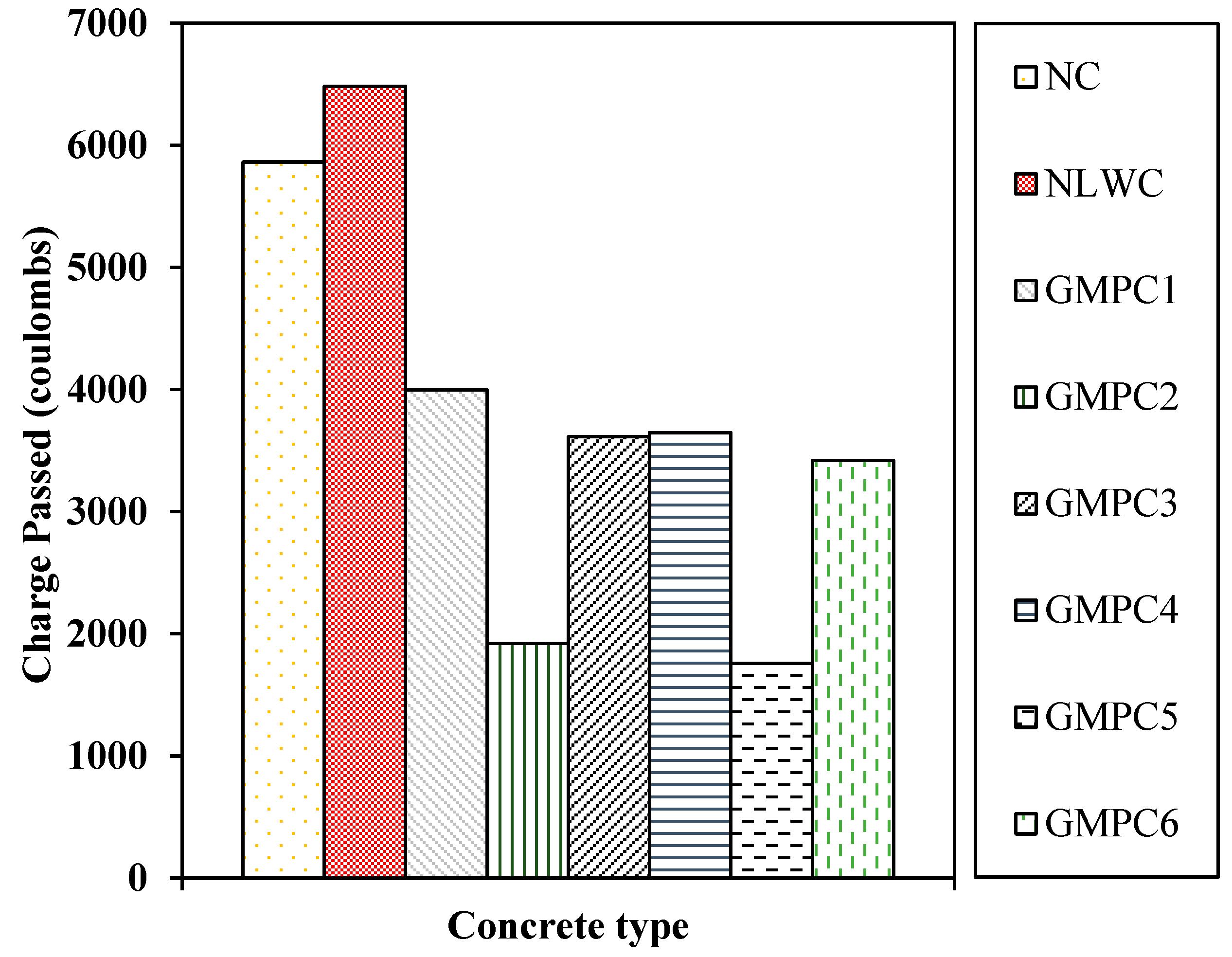
| Specific Property | Coarse Aggregate | Fine Aggregate | |||
|---|---|---|---|---|---|
| NW | NLW | CLW | Red Sand | Crushed Sand | |
| Type | Crushed | Uncrushed | Pelletized | Uncrushed | Crushed |
| Apparent Specific Gravity | 2.69 | 1.41 | 1.91 | 2.64 | 2.77 |
| Nominal Maximum Size (mm) | 10 | 10 | 10 | 1.18 | 4.75 |
| Fineness Modulus | 5.83 | 6.5 | - | 1.54 | 3.89 |
| Dry Unit weight (kg/m3) | 1554 | 697 | 889 | 1589 | 1599 |
| Absorption (%) | 1.48 | 18.6 | 16.82 | 0.28 | 1.67 |
| Concrete Type | Total Water | Free Water | Cement | Fine Aggregates | Coarse Aggregate | ||
|---|---|---|---|---|---|---|---|
| NW | NLW | GMPA | |||||
| kg/m3 | |||||||
| NC | 243.9 | 228 | 456 | 770 | 784 | - | - |
| NLWC | 299 | 228 | 456 | 909 | - | 352 | - |
| GMPC1 | 237.4 | 228 | 456 | 735 | - | - | 572 |
| GMPC2 | 235.3 | 228 | 456 | 729 | - | - | 535 |
| GMPC3 | 237.7 | 228 | 456 | 737 | - | - | 565 |
| GMPC4 | 240.8 | 228 | 456 | 708 | - | - | 637 |
| GMPC5 | 239.2 | 228 | 456 | 729 | - | - | 570 |
| GMPC6 | 242.6 | 228 | 456 | 729 | - | - | 618 |
| Property Type | Test | Testing Age (Day) | Standard Used |
|---|---|---|---|
| Fresh | Slump | - | [48] |
| Fresh density | - | [49] | |
| Hardened/Mechanical | Dry density | 28 | [50] |
| Compressive strength | 7, 14, 28 | [51] | |
| Splitting tensile strength | 7, 14, 28 | [52] | |
| Flexural strength | 7, 14, 28 | [53] | |
| Durability | Chloride ion penetration | 28 | [54] |
| Sr. No. | Designation | Plastic Waste % | Filler Type | Filler % |
|---|---|---|---|---|
| 1 | GMPA1 | 50 | Dune Dust | 50 |
| 2 | GMPA2 | 50 | Fly Ash | 50 |
| 3 | GMPA3 | 50 | Quarry Dust | 50 |
| 4 | GMPA4 | 30 | Dune Dust | 70 |
| 5 | GMPA5 | 30 | Fly Ash | 70 |
| 6 | GMPA6 | 30 | Quarry Dust | 70 |
Disclaimer/Publisher’s Note: The statements, opinions and data contained in all publications are solely those of the individual author(s) and contributor(s) and not of MDPI and/or the editor(s). MDPI and/or the editor(s) disclaim responsibility for any injury to people or property resulting from any ideas, methods, instructions or products referred to in the content. |
© 2023 by the authors. Licensee MDPI, Basel, Switzerland. This article is an open access article distributed under the terms and conditions of the Creative Commons Attribution (CC BY) license (https://creativecommons.org/licenses/by/4.0/).
Share and Cite
Alqahtani, F.K.; Zafar, I. Exploring the Effect of Different Waste Fillers in Manufactured Sustainable Plastic Aggregates Matrix on the Structural Lightweight Green Concrete. Sustainability 2023, 15, 2311. https://doi.org/10.3390/su15032311
Alqahtani FK, Zafar I. Exploring the Effect of Different Waste Fillers in Manufactured Sustainable Plastic Aggregates Matrix on the Structural Lightweight Green Concrete. Sustainability. 2023; 15(3):2311. https://doi.org/10.3390/su15032311
Chicago/Turabian StyleAlqahtani, Fahad K., and Idrees Zafar. 2023. "Exploring the Effect of Different Waste Fillers in Manufactured Sustainable Plastic Aggregates Matrix on the Structural Lightweight Green Concrete" Sustainability 15, no. 3: 2311. https://doi.org/10.3390/su15032311
APA StyleAlqahtani, F. K., & Zafar, I. (2023). Exploring the Effect of Different Waste Fillers in Manufactured Sustainable Plastic Aggregates Matrix on the Structural Lightweight Green Concrete. Sustainability, 15(3), 2311. https://doi.org/10.3390/su15032311







